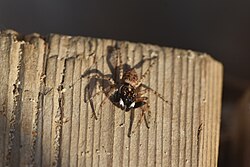Biology:Menemerus namibicus
| Menemerus namibicus | |
|---|---|

| |
| The related Menemerus semilimbatus | |
| Scientific classification | |
| Domain: | Eukaryota |
| Kingdom: | Animalia |
| Phylum: | Arthropoda |
| Subphylum: | Chelicerata |
| Class: | Arachnida |
| Order: | Araneae |
| Infraorder: | Araneomorphae |
| Family: | Salticidae |
| Subfamily: | Salticinae |
| Genus: | Menemerus |
| Species: | M. namibicus
|
| Binomial name | |
| Menemerus namibicus Wesołowska, 1999
| |
Menemerus namibicus is a species of jumping spider in the genus Menemerus that lives in Namibia. The species was first described in 1999 by Wanda Wesołowska. It is small to medium-sized spider with a dark brown carapace that is between 2.7 and 3.3 millimetres (0.11 and 0.13 in) long and a black abdomen between 3.7 and 4.9 millimetres (0.15 and 0.19 in) long. The spider's eye field is also black while the carapace is covered in grey hairs. The female epigyne has a large depression and strongly sclerotized entrance bowls, short insemination ducts and spherical spermathecae. The ridges at the very rear of the depression is characteristic of the species. The male has not been described.
Taxonomy
Menemerus namibicus is a species of jumping spider that was first described by the Polish arachnologist Wanda Wesołowska in 1999.[1] It is one of over 500 species identified by during her career, making her one of the most prolific in the field.[2] She allocated the spider to the genus Menemerus.[3] The genus was first described in 1868 by Eugène Simon and contains over 60 species.[4] The genus name derives from two Greek words, meaning certainly and diurnal.[5] The genus shares some characteristics with the genera Hypaeus and Pellenes.[6]
Genetic analysis has shown that the genus is related to the genera Helvetia and Phintella.[7] Previously placed in the tribe Heliophaninae, the tribe was reconstituted as Chrysillini by Wayne Maddison in 2015.[8] The tribe is ubiquitous across most of the continents of the world.[7] it is allocated to the subclade Saltafresia in the clade Salticoida.[9] In 2016, Prószyński created a group of genera named Menemerines after the genus.[10] The vast majority of the species in Menemerines are members of the genus, with additional examples from Kima and Leptorchestes.[11] The species is named for Namibia, the country where it was first found.[12]
Description
Menemerus namibicus is a small to medium-sized spider. The female has a dark brown carapace, covered in light grey hairs, that is between 2.7 and 3.1 millimetres (0.11 and 0.12 in) long and 2.0 and 2.3 millimetres (0.079 and 0.091 in) wide, with narrow white stripes formed of hairs on its edges. The eye field is black, with long brown bristles near its eyes. The spider has a low brown clypeus that also has a scattering of white hairs. The chelicerae, labium, maxilae and sternum are also brown. The abdomen is between 3.7 and 4.9 millimetres (0.15 and 0.19 in) in length and between 2.2 and 2.8 millimetres (0.087 and 0.110 in) in width. It is black on top and grey underneath. The spider has dark spinnerets and brown legs.[12] The epigyne has a large depression and strongly sclerotized entrance bowls that lead to short insemination ducts and spherical spermathecae.[13] The rims of the bowls appear as a straight line.[14] The male has not been described.[1]
Spiders of the Menemerus genus are difficult to distinguish.[15] Menemerus namibicus is most similar to Menemerus carlini.[16] The copulatory organs help to identify the species, particularly the straight edges to the rearmost edge of the depression on the epigyne.[14]
Distribution and habitat
Menemerus spiders are found throughout Africa and Asia, and have been identified as far as Latin America.[17] Menemerus namibicus is endemic to Ethiopia.[1] The female holotype was found in 1986, although an earlier example found in 1985 was also identified as the same species.[18] The spider has been found on the ground and in a mud dauber nest found in a farm building.[19]
References
Citations
- ↑ 1.0 1.1 1.2 World Spider Catalog (2017). "Menemerus namibicus Wesolowska, 1999". Bern: Natural History Museum. http://www.wsc.nmbe.ch/species/30738/Menemerus_namibicus.
- ↑ Wiśniewski 2020, p. 6.
- ↑ Wesołowska 1999, p. 251.
- ↑ Mariante & Hill 2020, p. 1.
- ↑ Fernández-Rubio 2013, p. 128.
- ↑ Maddison 2015, p. 233.
- ↑ 7.0 7.1 Maddison & Hedin 2003, p. 541.
- ↑ Maddison 2015, p. 231.
- ↑ Maddison 2015, p. 278.
- ↑ Prószyński 2017, p. 112.
- ↑ Prószyński 2017, p. 116.
- ↑ 12.0 12.1 Wesołowska 1999, p. 315.
- ↑ Wesołowska 1999, p. 316.
- ↑ 14.0 14.1 Wesołowska 1999, p. 258.
- ↑ Wesołowska 1999, p. 252.
- ↑ Wesołowska 1999, p. 274.
- ↑ Mariante & Hill 2020, p. 3.
- ↑ Wesołowska 1999, p. 314.
- ↑ Wesołowska 1999, p. 256.
Bibliography
- Fernández-Rubio, Fidel (2013). "La etimología de los nombres de las arañas (Araneae)" (in ES). Revista ibérica de Aracnología (22): 125–130. ISSN 1576-9518.
- Maddison, Wayne P. (2015). "A phylogenetic classification of jumping spiders (Araneae: Salticidae)". The Journal of Arachnology 43 (3): 231–292. doi:10.1636/arac-43-03-231-292.
- Maddison, Wayne P.; Hedin, Marshal C. (2003). "Jumping spider phylogeny (Araneae: Salticidae)". Invertebrate Systematics 17 (4): 529–549. doi:10.1071/IS02044.
- Mariante, Rafael M.; Hill, David E. (2020). "First report of the Asian jumping spider Menemerus nigli (Araneae: Salticidae: Chrysillini) in Brazil". Peckhamia 205 (1): 1–21. doi:10.5281/zenodo.3875200.
- Prószyński, Jerzy (2017). "Pragmatic classification of the World's Salticidae (Araneae)". Ecologica Montenegrina 12: 1–133. doi:10.37828/em.2017.12.1.
- Wesołowska, Wanda (1999). "A revision of the spider genus Menemerus in Africa (Araneae: Salticidae)". Genus 10: 251–353. http://www.biol.uni.wroc.pl/cassidae/menemerus.pdf.
- Wiśniewski, Konrad (2020). "Over 40 years with jumping spiders: on the 70th birthday of Wanda Wesołowska". Zootaxa 4899 (1): 5–14. doi:10.11646/zootaxa.4899.1.3. PMID 33756825.
Wikidata ☰ Q2158441 entry
 |

